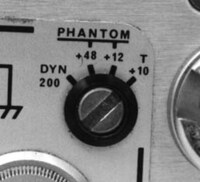 The topic for this article is mic powering, including Nagra "red dotting" and other basics pertaining to "phantom" powering of mics. If you are already intimately familiar with such terms as: T-powering; A-B powering; phantom powering; electret condenser; QPM 3-5; QPAU-T; and phasing cables -- then give yourself an A and skip on to another article in this website. But if any of this talk strikes you as resembling a call sheet from a sci-fi epic, then this primer is for you.
The topic for this article is mic powering, including Nagra "red dotting" and other basics pertaining to "phantom" powering of mics. If you are already intimately familiar with such terms as: T-powering; A-B powering; phantom powering; electret condenser; QPM 3-5; QPAU-T; and phasing cables -- then give yourself an A and skip on to another article in this website. But if any of this talk strikes you as resembling a call sheet from a sci-fi epic, then this primer is for you.
For the purpose of simplification, microphones will be divided into three basic categories: dynamic, condenser and electret condenser.
Dynamic microphones operate directly off of existing sound pressure. The sound waves themselves move an element (the mic diaphragm) in and out of a magnet, thus generating electric pulses (audio signals). Dynamic microphones require a fair amount of kinetic energy, which in turn makes them not as sensitive to subtle noises or faint sounds.
On the other hand, because they are so mechanically simple and durable -- dynamics are ideal to use in loud-noise situations, such as the recording of explosions. Used close to the mouth in a loud background situation, they will deliver a surprisingly clean voice track.
Dynamic microphones do not require any sort of external powering. Just connect them directly to a microphone level input and they are ready for use.
The next division of microphone power is electret condenser. Without getting too technical, this class of microphone employs a lightly charged electro-magnetic element. Whereas the dynamic microphone operates sort of like a generator, creating electrical impulses by passing a coil through a magnet, the electret condenser is more of a capacitor. That is, it varies the flow of an existing electric current based on actions caused by sound pressure. Think of dynamic microphones as manual typewriters, and electret condensers as office electric typewriters. The microphone does not have to generate electricity but rather just dispenses it.
The electret condenser class are considerably more sensitive to sound and can be made somewhat directional. For the most part, electrets work off of approximately 1.5 volts of DC current and draw very little power.
Powering for these mics is usually supplied via a built-in battery supply, found either in the "handle" of the mic or in the connector.
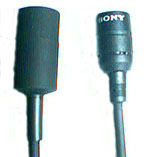 Virtually all of your professional lavaliers are of the electret condenser variety, such as: the Sony ECM44, ECM55; the MiniMic; the Tram TR50; Countryman EMW & B6, Audio Technica AT803 & AT899, and the Sennheiser MKE2. Most of these mics simply take one AA battery. The others, such as the TRAM, take one variety or another of a silver-oxide "button" battery (often located in an in-line plastic housing near the connector). When these mics are used as radio mics, they take their powering directly from the bodypack transmitter rather than their own bulky power supplies. As a convenience, some of these lavs can also be powered by Phantom power provided by mixing boards or some recorders.
Virtually all of your professional lavaliers are of the electret condenser variety, such as: the Sony ECM44, ECM55; the MiniMic; the Tram TR50; Countryman EMW & B6, Audio Technica AT803 & AT899, and the Sennheiser MKE2. Most of these mics simply take one AA battery. The others, such as the TRAM, take one variety or another of a silver-oxide "button" battery (often located in an in-line plastic housing near the connector). When these mics are used as radio mics, they take their powering directly from the bodypack transmitter rather than their own bulky power supplies. As a convenience, some of these lavs can also be powered by Phantom power provided by mixing boards or some recorders.
Most of the modular, screw-on capsule microphone systems are also of the electret type. A prime example is the Sennheiser K6 series (ME62 omni, ME64 cardioid, ME66 hypercardioid) that is so popular among video crews. At the heart of the system is the K6 battery supply/pre-amp, which utilizes an AA camera battery or remote Phantom power.
Another extremely popular electret condenser shotgun mic is the Audio Technica AT897. Though it is not modular, it is one of the top selling mics for video production, and powers from either an AA battery or remote Phantom power.
Very rarely does a battery go dead due to normal use. Most microphone manufacturers claim an estimated continuous working life of 1,500 to 3,000 hours per single battery. That’s at least two solid months or longer, even if you never take the battery out at the end of the day.
The most common cause of electret microphone failure is that the battery was installed backwards, or that no battery was installed at all. Sometimes, one of the battery contacts might only need some polishing (a crisp dollar bill works very well for that purpose).
Since electret condensers have their own battery supplies, they can be treated the same as dynamics as far as connecting them to a microphone level input is concerned. Just plug them in.
The third category of microphones, and the group that accounts for the most confusion regarding powering, is that of the RF condenser.
RF or true condenser microphones are the mainstay of the professional industry. They go beyond the electro-magnetic capacitor design of the electrets, instead employing sophisticated discriminator-tuned circuits. Suffice to say that RF condensers are capable of greater sensitivity and sound quality than their counterpart electrets, but condensers are physically more fragile. If we think of electret condenser mics as electric typewriters, then the condenser microphones are word processors.
A good example of condenser microphones include the Sennheiser "shotgun" mics which are so much a part of this industry -- namely, the MKH 416 and MKH 60; and the ever popular Audio Technica BP4073.
Condenser microphones require a stronger voltage in order to operate. This is usually either 12 or 48 volts, depending on model. Microphones intended for use in (music) recording studios commonly draw 48 volts, whereas mics intended for film and television originally used 12 volts.
There are four different designs of remote microphone powering. These are: 48v phantom; 12v phantom; (normal) 12v T powering (also referred to as 12v A-B powering);and the variant (polarity reversed) 12v T powering (also referred to as red dot or Nagra-style T powering).
The difference between phantom and T-powering is the route by which the powering voltage is transmitted to the microphone through the cable.
In T-powering (aka A-B powering), the 12 volts are sent to the condenser microphone through the standard three-pin XLR mic cable, employing pin 2 as positive and pin 3 as negative. Pin 1 is ignored.
In phantom powering, which exists in both a 12v as well as a 48v version, pin 1 is negative while (both) pins 2 and 3 are positive.
Condenser microphones do not contain their own power supply -- some sort of external powering must be employed. In studios, this may consist of either a 48v phantom power supply (running off of AC), or a provision in the mixing console to supply the condenser powering. For field work, the microphone powering can emanate from a battery supply, from some mixing panels, or from some recorders & camcorders.
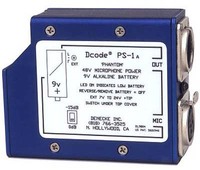 A few major audio companies (such as Denecke Inc and PSC) manufacture and market convenient battery power supplies. Normally, there are configured for 48v Phantom powering although some models for the less common 12v T powering are available. Measuring close to the size of a cigarette pack, these units work off of one or two 9v batteries and may contain built-in pads and low-cut filters. These units are employed between the condenser microphone and the mic level input. The output from these units going to the recorder is considered by the recorder as the same as if coming from dynamic microphones. In other words, no special pre-amps able to supply (and filter) mic powering are required by the host recorder.
A few major audio companies (such as Denecke Inc and PSC) manufacture and market convenient battery power supplies. Normally, there are configured for 48v Phantom powering although some models for the less common 12v T powering are available. Measuring close to the size of a cigarette pack, these units work off of one or two 9v batteries and may contain built-in pads and low-cut filters. These units are employed between the condenser microphone and the mic level input. The output from these units going to the recorder is considered by the recorder as the same as if coming from dynamic microphones. In other words, no special pre-amps able to supply (and filter) mic powering are required by the host recorder.
Denecke PS1-A Phantom Power Supply
In lieu of using a battery power supply, most production mixing panels have the capability of providing phantom powering directly. Make certain that the panel is designating the type of powering that the mic requires. Phantom is not the same as T-powering (A-B powering). Although there are a few mixing boards that still offer a selectable choice of T power or Phantom, the vast majority of mixers these days are set up for Phantom power only. However, PSC does make an adapter that converts Phantom power to T power.
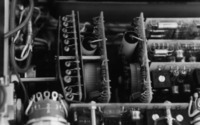 Some background information about the two forms of T power and their motion picture origins. Early condenser shotgun microphones were designed to be powered directly out of a Nagra -- providing that the proper pre-amps have been installed in the recorder. Nagras use two microphone pre-amp modules (one each for Mic Input 1 and Mic Input 2), which are selected from the following choices: QPSE-200-XOYO QPM3-5, or QPAU-T/QPU-T.
Some background information about the two forms of T power and their motion picture origins. Early condenser shotgun microphones were designed to be powered directly out of a Nagra -- providing that the proper pre-amps have been installed in the recorder. Nagras use two microphone pre-amp modules (one each for Mic Input 1 and Mic Input 2), which are selected from the following choices: QPSE-200-XOYO QPM3-5, or QPAU-T/QPU-T.
The "regular" pre-amps (QPSE.200-XOYO) are made for standard low-impedance dynamic microphones. These pre-amps will also work with (self-powered) electret condenser mics, or with condenser microphones if they are (self) powered from an external battery power supply.
The QPM 3-5 pre-amp is strictly designed for T-powered condensers, such as the Sennheiser MKH416T, MKH816T. It will provide the necessary DC voltage. However, because T power sends voltage up the same wires as the microphone sends audio down, there is a large potential for electrical interference (cancellation of audio). What that means in the real world is that you can only use mics designated as T power with the presence of T powering. Otherwise, you will end up with little or no audio!
 Nagras could be ordered or equipped with a choice of two regular pre-amps, two 3-5s, or one of each. An end user could specify what they wanted when ordering or renting. Remember though, a condenser mic with a power supply will work with the regular pre-amp, but a dynamic or electret mic will not work with a QPM 3-5 (T-power).You’ll get no audio! So don’t lock yourself in to using the QPM 3-5 pre-amp unless you are certain that only condensers are going to be used on the shoot.
Nagras could be ordered or equipped with a choice of two regular pre-amps, two 3-5s, or one of each. An end user could specify what they wanted when ordering or renting. Remember though, a condenser mic with a power supply will work with the regular pre-amp, but a dynamic or electret mic will not work with a QPM 3-5 (T-power).You’ll get no audio! So don’t lock yourself in to using the QPM 3-5 pre-amp unless you are certain that only condensers are going to be used on the shoot.
Later Nagras could be equipped with the Universal pre-amps (QPAU-T/QPU-T). These pre-amps are switchable and can be selected for use with dynamic, T-powered or Phantom powered mics. The QPAU-T is the mother pre-amp and is found in the Mic One position only. To change between mic settings, there is a slotted adjustment switch near the left side corner. The QPU-T pre-amp is for Mic Two only, and is adjustable from the inside of the machine. Ask a technician to show you how it works.
If you are using a Nagra with Universal pre-amps, and the mic doesn’t work, make sure the pre-amp selector switch is in the correct position. A hint: dynamic is at one extreme of the switch and T-powering is at the opposite extreme.
Another interesting means of powering a mic from a Nagra is to employ a KAT cable amplifier (made at one time by Sennheiser). This small device plugs into the accessory socket of the Nagra and takes its power directly from the machine. The power drain on the Nagra is negligible. The KAT, besides providing T-powering, also expands the capability of the Nagra because it converts the line input pot into an additional microphone input. The KAT is switchable for use with either condensers or regular dynamic mics.
Now here is the great source of confusion. Nagra pre-amps are wired the reverse of the standard audioindustry, when it comes to pin 2 and pin 3 of the microphone input. The reasons are complex and vague, but that’s the way it is. What this means is that the T-powering coming from either the QPM 3-5 or the Universal pre-amp shows pin 2 as negative (whereas the rest of the recording industry always designates Pin 2 as positive); and pin 3 is now positive (whereas it is usually negative). In other words, the electrical polarity is reversed on Nagras compared to the rest of the world.
However, since Nagra was the standard of the motion picture industry, it became common practice to simply reverse the leads for pins 2 and 3 inside of the condenser microphones to make them Nagra compatible. To indicate that this modification had been performed, the outside casing of the microphone is traditionally marked with a red dot -- hence the expression "red dotting."
The problem is that the end user must be cognizant of not only whether or not his or her microphone is standard or red-dot, but also of the polarity of any battery power supplies as well as the polarity of any remote powering capabilities of the mixing panel. Make sure everything is compatible.
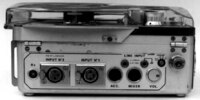 A life-saving accessory is the phase-reversing cable. This is merely an adapter or foot-long XLR cable, in which the leads to pin 2 and pin 3 have been reversed at one end. One of these, inserted between the condenser microphone and the power source, will correct any "red-dot to standard" mismatch that may have occurred either due to oversight or the last minute addition or replacement of equipment.
A life-saving accessory is the phase-reversing cable. This is merely an adapter or foot-long XLR cable, in which the leads to pin 2 and pin 3 have been reversed at one end. One of these, inserted between the condenser microphone and the power source, will correct any "red-dot to standard" mismatch that may have occurred either due to oversight or the last minute addition or replacement of equipment.
Finally, it is important to remain aware that by switching around pins 2 and 3, the acoustic phasing of the microphone has been reversed. There is a difference in meaning between acoustic phasing (the audio signal) and polarity (voltage supplied to make the mic work). If you are employing more than one microphone at the same time, you might have to reverse the acoustic phasing of some of the mics (even dynamics and electrets) in order to prevent the mics from partially cancelling each other out. This would entail either throwing a switch in the mixing panel, or inserting a phasing cable between the mic and the input. In the case of condenser mics, a phasing cable might be inserted between the power supply and the input. Let your ear be the judge.
Phantom powering does not have this polarity issue, since it deploys a balanced form of mic powering that sends the positive voltage equally up both Pins 2 and Pins 3, and uses Pin 1 for the negative. This form of mic powering has no impact on the incoming audio signal, so it does not cause (acoustic) problems when using dynamic or electret condenser (self powered) mics. At least not in theory…but some engineers warn that you should be cautious when plugging in any electronic mic, because there always is the slight chance that the 48v Phantom power could create electrical issues.
Personally, I have used Phantom power for decades and never experienced any issues, except with some radio mics. But I have encountered problems created when a mixer was plugged into the XLR inputs of a field recorder (that had Phantom power turned on, hence interfering with the connection to the mixer).
So why did the early motion picture industry choose T power when Phantom power seems like such a better choice? Afterall, the recording studios had been using Phantom power for decades prior.
It all had to do with being portable. In the studio, there is 117v AC power to run the mixing board and recorders. It is a simple task to reduce that much voltage down to 48 v in order to run microphones.
But in the early 1960’s, portable meant 12 flashlight batteries, such as D cells. That amounted to a power source of only 18 volts. Shotgun mics were therefore designed to work with only 12 volts. Over in Europe, where the Nagra and the Sennheiser mics originated, the audio industry used a five pin DIN mic connector. Three pins were designated for the audio, and two pins were reserved for powering.
In the USA, the three pin XLR connector ruled. And the Nagra was the standard of the industry. The Nagra was also electrically grounded the opposite of most things in the USA. So somewhere in that mess came the practice of using T-power in the XLR three pin connector, and wiring it compatible with the Nagra. It wasn’t until the television industry came around that anyone noticed or cared that their Sennheiser shotgun mics were wired strangely.
During the early space age, the state of portable electronics advanced by leaps and bounds. Eventually it became feasible to convert 18v DC to 48v DC without a carload of circuit boards.
Along with the rising popularity of portable video being used in television broadcasting, Phantom power quickly replaced the original T-power as the new standard for audio.
Today, ultra quiet battery powered Phantom supplies such as those made by Denecke can even produce 48v Phantom from just a single 9v battery. That, and the fact that nearly all professional portable recorders and mixers are capable of providing Phantom power, has made Phantom the new default standard.
But there are still a huge number of the older T powered shotgun mics floating around, so it was worth your time to learn about them by reading this article.